Bonnie Ferrante's Blog, page 96
June 4, 2014
Graham, Bob. Oscar’s Half Birthday. Book Review.
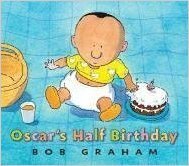
This is a gentle, warm book about a family of four celebrating a little boy’s sixth month birthday. We are never told why this is so important, why the family can’t wait until he is one year old. That, in itself, could generate some interesting discussion.
The mother, father, sister Millie, and baby Oscar go on a picnic. When the parents light a candle on Oscar’s cake, all the people in the park who have been admiring the baby, join in singing “happy birthday.” Millie wears fairy wings throughout the journey as the family enjoys such simple gifts as the wind in the trees, the roar of the train, and the sunshine in the park. The writing is, at times, pure poetry. “Oscar frowns in the dim light – six different expressions on his face in the time it takes a leaf to fall.” and “The wind carries their song up over the hill, out across the traffic, higher than churches and factories and apartment buildings. It’s sound falls gently over the city – so faint that, only dogs can hear it. And somewhere down there, the one who started all of this… the half-birthday boy, Oscar, sits tilted at an angle, his fingers curled into Millie’s tuna sandwich. His shoulders are hunched, his head nods, and the light shines through his ears, illuminating them like little lanterns.”
This is a story infused with gentle love. It would be a wonderful book to share with a child who has a tiny baby sister or brother.
The illustrations are soft watercolors, often two-page spreads. They are simple but engaging. The mother is of African descent and the father is of European descent. At the end, each parent is carrying a well-loved, sleepy child.
Highly recommended.


June 2, 2014
Hoban,Tana. Look Up, Look Down. Book Review.
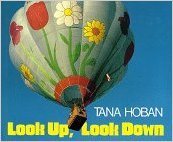
This is a wordless early childhood concept book. Each page holds a single photograph. The child must identify whether they would look down or look up to see the item in the picture. Children might enjoy looking through the pages but this book is structured to be used by an adult with a preschooler, ages 2 to 4.
There are a wide variety photographs, some quite clever such as the one taken from below the bleachers. It was published in 1992, and at that time the photographs would have been praised. But, in 2014, when hundreds of astonishingly beautiful photographs are available for viewing on the Internet, these photos might not be as captivating as they once were.
Depending on the age and ability of the child, this book would most likely be read only once. However, if an adult wanted to extend the learning experience I would encourage a “look up, look down” walk. Bring a digital camera and have the child photograph things that are up and things that are down. This could be made into a simple slideshow or printed and cut and pasted into the child’s own book.
Well Recommended.


June 1, 2014
Aliki. A Medieval Feast. Book Review.
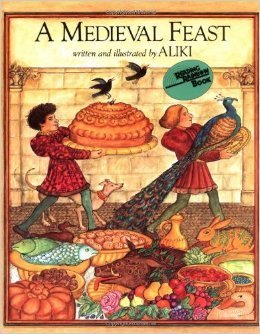
Aliki’s book is classed as fiction but would be more useful to a teacher or student as nonfiction. It explains an incident instead of telling a story. From first notice to the end of the meal, Aliki explains what was involved in creating a medieval feast for a visiting King. She clearly describes the gathering, processing and preparing, and presentation of meat, fish, and baked items. Along the way, she clarifies the class system of the Middle Ages. Readers will be astonished at the work and expense expected from the host. Food presentation was elaborate to the point of pageantry.
As well as a step-by-step detail of the meal, Aliki adds notations to her detailed illustrations, such as, “Trenchers were flat, coarse bread used in place of plates. Peasants ate theirs, but the rich gave their trenchers to the poor. Other breads are made of the finest flower.” In the picture we see a peasant harvesting grain with the scythe, a miller grinding the seeds with a waterwheel powered mill, a baker loading the stone oven, and two men carrying away the finished trenchers.
Using the tapestries of Medieval times for inspiration, Aliki frames her pictures with patterns and imitation gold leaf. The scenes are drawn in the style of 15th century illustration. Several pages have tiny labelled illustrations of plants and animals used in meals.
This book would be a valuable addition to any classroom studying Medieval Times. Children interested in the lavishness of historic royalty would also enjoy the book.
Well recommended.


Interview with Marianne Jones – Author
Available from Split Tree Publishing
Today I am interviewing Marianne Jones, an author of many talents. Here she is at Port Arthur’s Landing in Thunder Bay on a stone bench that features one of her poems.
Tell us a little about yourself and your background?
I’m from Thunder Bay, married, with two daughters and two granddaughters. I’m also a retired elementary teacher and children’s choir director, an actor and director.
What is your children’s picture book about?
Great-Grandma’s Gifts is the story of a little girl named Arlene who loved to sew. When she grew up she sewed clothes for her children, and later, from the leftover fabric, toys for her grandchildren. When her grandchildren grew up, she turned to sewing quilts for her grandchildren. The story celebrates the bond between the generations, and how a grandmother expressed her love for her family through the work of her hands.
In what formats is your book available?
In hard cover, soft cover and ebook from Amazon and Split Tree Publishing.
Is this your first picture book? You often write poetry. How is that similar to writing picture books? How is it different?
This is my first picture book, but not my last! The picture book is written with rhythms, repetition, and metaphors, similar to poetry. Unlike most of my poetry, it is a narrative with a beginning, a middle and an end. And, of course, it is written using child-friendly vocabulary!
This story seems to be based on a family experience? Do you have any other family experiences you are planning on using for a children’s books?
I wrote this story so that my grandchildren would know about their great-grandmother, my Mom, who passed away recently. I wanted them to know what a creative, talented person she was, and what a legacy of beautiful quilts and crafts she left behind. My sequel, Where is Peachy Keen? is about the grandchildrens’ favourite toy she made, which they christened Peachy Keen.
Is there a message in your book that you want readers to grasp?
I want them to know that elderly relatives were once children, too. I want them to know about a generation that was thrifty, that recycled everything, and that showed love through their creative talents and time, rather than buying expensive, disposable things.
Do you recall how your interest in writing originated?
I was always trying to describe things, searching for the exact right words, even as a young child. I got so much delight from reading books, and from writing, that it came to me one day with startling clarity that I wanted to do this for a living. What could be better than creating those things that had given me so much pleasure?
Is there anything you find particularly challenging in your writing? How do you manage it?
My biggest challenge is plotting a story, and fighting my inner critic. The support of other writers helps, and “just showing up.” It’s surprising what you can come up with when you just start!
Do you have a special time to write or how is your day structured?
Mornings are usually best, when I’m fresh. Every day is different, though, with family and other responsibilities, so structure is hard to attain.
What was your favourite childhood picture book?
I loved The Cat in the Hat in grade one. I don’t remember any early reader books at home. My favourite childhood book, which I still have, is an elaborately illustrated book of fairy tales my mother gave me. It had some wonderful and exotic stories in it that I still love, and some scary ones, too. One day my grandchildren will be old enough for it.
What were your goals and intentions in this book, and how well do you feel you achieved them?
My intentions were twofold: I wrote Great-Grandma’s Gifts for my granddaughters, because I knew they wouldn’t know their great-grandmother as they grew up. I also wrote it for my mother, to honour her exquisite needlework, and her legacy. I am happy that I achieved both purposes. My granddaughters are too young right now, but in years to come, they will “know” their great-grandmother somewhat through the book. And my mother was able to see the book before she passed away. She was very proud of it, and displayed it in her room in the nursing home. So I will always feel good about that. Sometimes we take it for granted that people know how we feel about them, but it’s always good to express it while they’re alive.
Who illustrated your book?
My sister, Karen Reinikka, did the illustrations, so that the book was truly a joint effort and a family gift. We consulted with each other on the text and the illustrations.
What do you like to read in your free time?
Literary novels mostly, but some nonfiction, mysteries and poetry.
What part of your writing time do you devote to marketing your book?
I’m trying to sort that out. Like most writers, I’m not totally comfortable with that aspect, but I’m trying to get better at it. Still, I don’t want it to take over, and take away from the creative process.
Is there any marketing technique you used that had an immediate impact on your sales figures?
I think my publisher could answer that better than I could. I still find chatting with people at booktables and launches to be effective. The personal touch still works. But I’m still learning.
What have you enjoyed the most about the creation of this picture book?
What thrills me is seeing how people react—tearing up, because it reminds them of a mother or grandmother who made things for them. What was initially a personal tribute has turned out to resonate with many.
Do you have anything specific that you want to say to your readers?
I hope that they enjoy this book, and sense the love with which it was written. There is a richness in life’s simple experiences. That was something my mother understood well.
Thank you for sharing with us today. How can readers discover more about you and you work?
Website:http://www.mariannejones.ca
Blog: http://www.mariannejones.ca
Facebook:http://www.facebook.com/MarianneJonesAuthor
Twitter:http://www.twitter.com/Mariann36863659
Lnkedin:http://www.linkedin.com/mariannejones
Amazon Author Page:http://www.amazon.com/author/jonesmarianne
Goodreads:http://www.goodreads.com/author/dashboard


May 30, 2014
Rayne Shines Giveaway
Teddy O’ Malley rated it 5 of 5 stars
“Rayne Shines is a book with a hilarious twist on learning to count your blessings.
Rayne is a young frog whose family always complains. Mom complains about movies. Dad complains about music. Everybody has something to complain about. Rayne was brought up to complain right along with them.
But one day new neighbours arrive. Their little girl, Sunny, always sees the positive in everything. Maybe after playing with Sunny for a while, Rayne will learn to see the positive side of things, too.
This is a great way to introduce to introduce any child (or even an older person) to positive thinking. Rayne Shine shows how much fun it isn’t to hang out with people who do nothing but complain!
When Rayne alters her perception by seeing the positive in everything, instead of the negative, thanks to her friend Sunny, she learns that it can alter your mood and make you feel better and happier!
The book is simple and can deliver its message to even the youngest of readers. The illustrations were wonderful and matched the story well. I really enjoy looking at them as I read through the story.
The positive message in Rayne Shines make this book top shelf!
- Destiny’s Book Dig Up”
https://www.goodreads.com/giveaway/show/93328-rayne-shines


May 29, 2014
Waddell, Martin. Farmer Duck. Illustrated by Helen Oxenbury. Book Review.
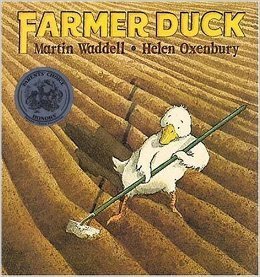
This is the story of a hard working duck who does all the farm chores while the lazy farmer lays in bed reading the newspaper and eating chocolates. The only contribution the farmer gives is to call out periodically, “How goes the work?” To which the duck responds “Quack!” Finally the exhausted duck gains the sympathy of the other animals who drive out the farmer. From that point on all the animals pitch in to help on the farm.
I found the realistic illustrations of animals an odd juxtaposition to their behavior. Animals bring in the hay, gather the eggs, do the ironing and the dishes, saw the word and plant the garden. The duck even brings breakfast in bed, including a sundae with a cherry and little umbrella, to the farmer. As with all Helen Oxenbury’s illustrations, the soft watercolors are realistic and detailed, down to the armpit hair on the big bellied farmer. Although they are quite humorous at times, they give the story a sensation of sweetness.
The story seems to be a variation on The Little Read Hen. The reader feels pity for the overworked duck and disgusted with the lazy farmer. When the other farm animals decide to support the deck, the reader is happy to see the pajama clad farmer driven down the lane, through the fields, over the hill, and never to return.
The double spread last page reads, “Then mooing and baaing and clucking and quacking, they all set to work on their farm.” I would’ve liked something more. Perhaps a suggestion of what the duck no longer had to do: dishes, ironing, and breakfast in bed for example. Does she still gather the hens eggs? Is the cow milked? How have the chores changed? Now that the duck has so much help, does she have time to relax or play?
Recommended.


May 28, 2014
Cute Gifts

Looking for a cute gift for that special child in your life. Check out the Kids Store.
http://www.cafepress.com/bonnieferrantekids


May 27, 2014
Willems, Mo. There Is a Bird on Your Head! Book Review.
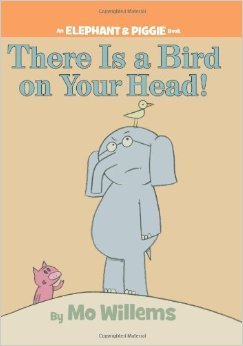
It is very difficult to find an early reading book that can hold a child’s interest. Mo Willems rivals Dr. Suess in a charming sense of fun. His book does not rhyme, but instead has a single sentence, sometimes a single word, on each page. The vocabulary could be handled by children in early first grade. It is a large book, at 57 pages, but a quick read.
It is the story of an elephant to has an unwanted bird, which expands to be two birds and a nest, on his head. The birds, elephant, and pig are simply drawn but the consternation of the elephant comes across clearly.
The book is laugh out loud funny. There are several moments where children will pause to enjoy the humor. The ending is satisfying and silly. Children will enjoy reading and rereading this book.
This book would be a cute Easter gift or springtime present for the beginning reader.
Highly recommended.


May 25, 2014
20 Questions to Ask a Picture Book Manuscript

Today I’m sending all the picture book writers out there to someone else’s blog because it’s just that good.
http://rachelhamby.com/for-writers/


Ray, Jane. The Dollhouse Fairy. Book Review.
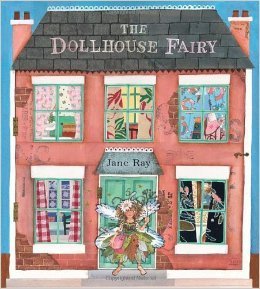
Rosy and her dad create a beautiful dollhouse together. They have a loving and warm relationship. But one day, Dad is taken to the hospital and, for the first Saturday ever, Rosy and her father don’t share hot chocolate and French toast for breakfast. When Rosy goes to play with her dollhouse, she discovers an injured fairy named Thistle. The bulk of the story consists of Rosy helping the messy, mischievous fairy, named Thistle, to recover. When Dad returns from the hospital, Thistle is gone. Together, father and daughter clean and repair the dollhouse. Dad leaves out “a tiny piece of cake for Thistle, just in case….”
The possibility of losing a parent is probably the most frightening concept a child encounters. Rosy copes with this terrifying thought by fantasizing a relationship with the fairy and acting out her frustration on the little dollhouse. Young children will believe that the fairy was real, that this was Rosy’s way of using her imagination to cope. Thistle is an expression of her pain.
This story would be a gentle way to open discussion with a child whose parent has been hospitalized. It lends itself well to conversation about changes in behavior. I would not suggest that the adult explain that Thistle wasn’t real and Rosy actually made the mess. You might want to let the story work its own magic. The Dollhouse Fairy is a story for adults as much as children. The father provides a beautiful example of how adults need to accept, without judgment, the way children cope with grief and fear.
Jane Ray’s illustrations, once again, are detailed and fascinating. Children will be intrigued by all the tiny items in the dollhouse. The love between parent and child and family is apparent in the body language and expression of the characters. I especially like that the family is interracial and intergenerational.
Well recommended.







